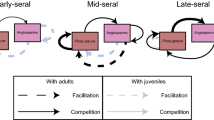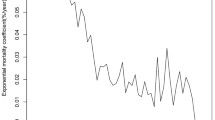Abstract
The survivorship curve is estimated for theAbies population of the subalpine wave-regenerated forest on Mt. Shimagare in the northern Yatsugatake Mountains, Central Japan. The repetition of decay and regeneration of nearly even-aged stands is the nature of this forest in a steady-state, so that the survivorship curve is given as the decrease of density with stand age. Four distinct stages are recognized on the curve. The mortality is high in the first 10 years (stage i). Though germination is observed from the floor under dense canopy to the forest edge, only a portion of the seedlings can survive and form a nearly even-aged young regeneration. The established regeneration enjoys a low mortality before it attains a full density state (stage ii, until 32 years). When full density is reached, as indicated by the −3/2 power law, the mortality increases again due to an intensive self-thinning (stage iii). However, mortality rate declines with age. This decline is thought to occur because canopy trees become uniform in size and spatial distribution. In the last stage the aggregative dying-off of trees takes place (stage iv, about 90 years). The uniformity among trees is believed to promote the collapse of the stand.
Similar content being viewed by others
References
Hett, J.M. andO.L. Loucks. 1976. Age structure models of balsam fir and eastern hemlock. J. Ecol.64: 1029–1044.
Kamitani, T. andK. Maruyama. 1978. Structure of naturalAbies mariesii forest in Mt. Nacba I. Stratification and pattern of spatial distribution in closed stand. Bull. Niigata Univ. Forests11: 37–49 (in Japanese).
Khilmi, H.F. 1957. Teoreticheskaya Biogeofizika Lesa. Akademii Nauk SSSR, Moskva Cited from Japanese translation by K. Takahashi (1975), Tatara-Shobo, Yonago.
Kimura, M. 1963. Dynamics of vegetation in relation to soil development in northern Yatsugatake Mountains. Jap. J. Bot.18: 255–287.
Kira, T. andT. Shidei. 1967. Primary production and turnover of organic matter in different forest ecosystems of the western Pacific. Jap. J. Ecol.17: 70–87.
Kohyama, T. 1980. Growth pattern ofAbies mariesii saplings under conditions of open-growth and suppression. Bot. Mag. Tokyo93: 13–24.
Koyama, H. andT. Kira. 1956. Intraspecific competition among higher plants VIII. Frequency distribution of individual plant weight as affected by the interaction between plants. J. Inst. Polytech., Osaka City Univ., Ser. D7: 73–94.
Kuroiwa, S. 1959. Ecological and physiological studies on the vegetation of Mt. Shimagare III. Intraspecific competition and structural development of theAbies forest. Bot. Mag. Tokyo72: 413–421.
Leak, W.B. 1975. Age distribution in virgin red spruce and northern hardwoods. Ecology56: 1451–1454.
Mohler, C.L., P.L. Marks andD.G. Sprugel.. 1978. Stand structure and allometry of trees during self-thinning of pure stands. J. Ecol.66: 599–614.
Morisita, M. 1959. Measuring of the dispersion of individuals and analysis of the distributional patterns. Mem. Fac. Sci. Kyushu Univ., Ser. E2: 215–235.
Ogawa, H. andT. Kira. 1977. Methods of estimating forest biomass.In: T. Shidei and T. Kira, ed., Primary Productivity of Japanese Forests, JIBP Synthesis16: 15–25. Univ. of Tokyo Press, Tokyo.
Oshima, Y., M. Kimura, H. Iwaki andS. Kuroiwa. 1958. Ecological and physiological studies on the vegetation of Mt. Shimagare I. Preliminary survey of the vegetation of Mt. Shimagare. Bot. Mag. Tokyo71: 289–300.
Sprugel, D.G. 1974. Natural disturbance and ecosystem responses in wave-regeneratedAbies balsamea forests. Ph. D. thesis Yale Univ., New Haven, Connecticut.
— 1976. Dynamic structure of wave-regeneratedAbies balsamea forests in the northeastern United States. J. Ecol.64: 889–911.
Takahashi, F. 1979. Wave-regeneratedAbies veitchii forests in Mt. Shimagare—Movement of the “dead trees strips” during 28 years. Shinrin-Kosoku (Japan Forest Technical Ass., Tokyo)122: 10–17 (in Japanese).
White, P.S. 1979. Pattern, process and natural disturbance in vegetation. Bot. Rev.45: 229–299.
Yoda, K., T. Kira, H. Ogawa andK. Hozumi. 1963. Self-thinning in overcrowded pure stands under cultivated and natural conditions. J. Biol. Osaka City Univ.14: 107–129.
Author information
Authors and Affiliations
Rights and permissions
About this article
Cite this article
Kohyama, T., Fujita, N. Studies on theAbies population of Mt. Shimagare. Bot Mag Tokyo 94, 55–68 (1981). https://doi.org/10.1007/BF02490203
Received:
Issue Date:
DOI: https://doi.org/10.1007/BF02490203




